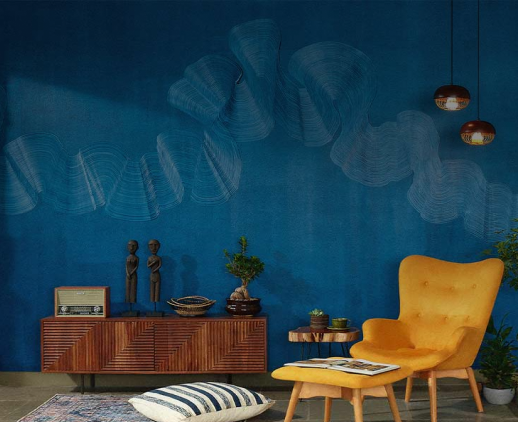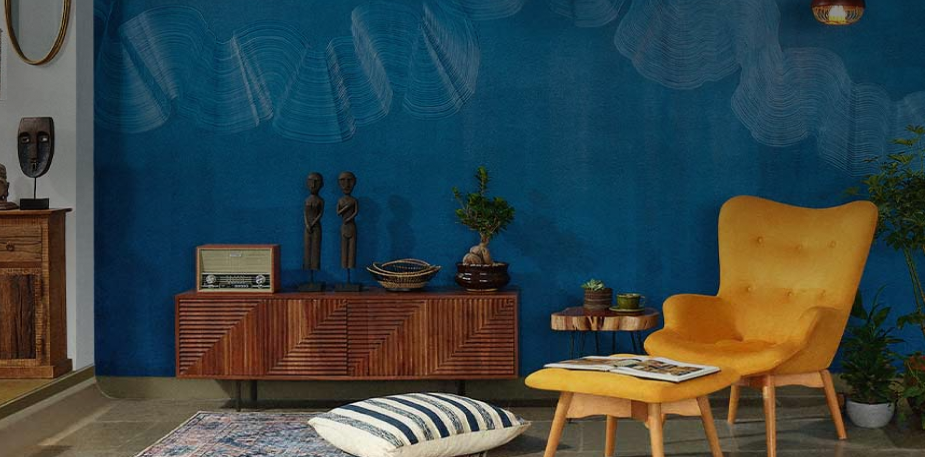Get your home interior design budget estimate
Flintstone 6: A sleek, modern farmhouse with a sustainable flair

This single-storey cottage in a farming community in rural Tamil Nadu blends into the terrain it is inspired by
Flintstone 6 was originally supposed to be a weekend farm getaway for Abhishek Ubale and his family—an escape from city life in the community of Sanctity Ferme, Shoolagiri village, Tamil Nadu (about 70 kilometres from Bengaluru).
But when the pandemic hit and brought with it WFH and prolonged shelter-in-place orders, they decided to make it their permanent home and shift base. Since the plot was part of a larger farming community, the owners were clear it had to be a simple, sustainable home and not a concrete monstrosity. Abhishek reached out to architect Fawaz Thengilan of Studio Mitti to create a home that would blend into its surroundings, without disturbing the existing landscape.
Beautiful Homes: Can you tell us about the project and what the homeowners wanted?
Fawaz: This is a single-storey, 2-bedroom, 2,000 sq ft cottage built on a farming community on the outskirts of Bengaluru. It’s a fairly simple structure—two bedrooms facing East, a multi-function living-cum-kitchen in the heart of the house, and a West-side car porch. The terrain is what sets it apart.
There are a lot of pristine lands available for sale beyond the Bengaluru-Hosur area, and this plot was in such a community, called Sanctity Ferme, which was already building sustainable model houses on the farm. The owner’s main ask was that we create a home that would not spoil the landscape and stick out.

Abhishek Ubale with architect Fawaz Thengilan of Studio Mitti.
BH: Can you tell us about the design philosophy and where you drew inspiration from?
Fawaz: The owners wanted the home interior design to blend in with the landscape… a house that would not conflict with nature; not too loud or flashy. The home also had to withstand the heat, so we had to create something with water bodies and lots of shade. Considering the dry, arid land and climate, the house had to be customised to the surroundings and not the individuals. The cottage is nestled amongst mango trees, cacti and majestic, rocky boulders that are common to the Deccan Plateau. The entire home has been designed drawing from these elements and in harmony with them.
BH: Is the entire structure made of natural materials?
Fawaz: Largely, yes, and we have used an earthen palette all over the house. We tried to use as much “waste” material as possible from the land. For the walls, we used a Poured Earth Debris Wall (PEDW) construction technique that combines soil and quarry debris in a specific ratio, all sourced from the area. The bedroom floors are done in polished concrete, and for the roof, we used local casuarina wood and ferrocement (reinforced mortar poured over wire mesh), which is covered by a low-energy glass roof. The carpentry has been done in plywood.
BH: Two recurring design elements are boulders and a rounded, smooth pebble shape which is seen in the mirrors, door handles handles, and wardrobes—can you tell us about that?
Fawaz: The home is situated near the Deccan Plateau and Cauvery River basin and the region is dotted with boulders. The plot itself has many boulders, so we took inspiration from that. We created a composition using boulders and then turned it into artwork. This was also an attempt to make the space look seamless and natural; to adapt to the natural disturbances in the terrain and incorporate it into the space. Since we couldn’t use boulders in the construction as such, we took them as a reference point to create those standout design elements. And it’s quite a conversation starter!

The home is surrounded by mango trees.

The home has been built using natural materials like reclaimed wood, stone and concrete.
BH: You have built into the land in some places, bringing trees into the home. Was this challenging?
Fawaz: The plot already had several mango trees. So, we had some trouble finding an extended space for the home structure without cutting the trees. The thing is, when we skirt around trees and build away from them, the home ends up getting less space and volume. On the other hand, trees inside a room can be a hindrance. This was a bit of a challenge. However, when we align the trees to a wall, we get more space and there is less functional hindrance— so that’s exactly what we did.
BH: How is the temperature maintained within the house? Is it completely air-cooled?
Fawaz: There are zero ACs in the home! We have used low-energy glass to cut the heat (it cuts infra-red heat). The ceilings have been designed in such a way that there are vents between the low-energy glass and casuarina wood roof.
BH: Flintstone is overall quite a low-impact and eco-friendly home. Was that the intent from the beginning?
Fawaz: We didn’t go in with the idea of building carbon-neutral, eco-friendly or sustainable home. We simply took the client’s brief (a home that blends into the surroundings) and used the logic of not harming the planet. We used the techniques we already knew to make as low an impact as possible, using waste materials, reclaimed wood, etc. One sustainable home alone won’t reverse what’s happened to the environment, but by adopting these practices, we can plant a seed to slow down further ecological damage.

Get Started with your interior design journey with us!
Speak to our design professionals
What’s the status of your home possession?
What’s the condition of your home/space?
Will you be living in your space during the renovation?
 Previous Question
Previous Question
Is your interior design budget over 4 lakhs?
 Previous Question
Previous Question
Book next available appointment slots with our experts!
Please Select Date and Day
 Previous Question
Previous Question

Something went wrong!
We were unable to receive your details. Please try submitting them again.

Appointment Scheduled!
Thank you for giving an opportunity to Asian Paints Beautiful Homes Service! Our Customer Experience Specialist will get in touch with you soon.
Appointment Date & time
Thank You!
Our team will contact you for further details.
What’s the status of your home possession?
What’s the condition of your home/space?
Will you be living in your space during the renovation ?
 Previous Question
Previous Question
Is your interior design budget over 4 lakhs?
 Previous Question
Previous Question
Book next available appointment slots with our experts!
DEC 2023
Please Select Date and Day
 Previous Question
Previous Question

Something went wrong!
We were unable to receive your details. Please try submitting them again.

Appointment Scheduled!
Thank you for giving an opportunity to Asian Paints Beautiful Homes Service! Our Customer Experience Specialist will get in touch with you soon.
Appointment Date & time
17 Oct 23, 03.00PM - 04.00PM


















































